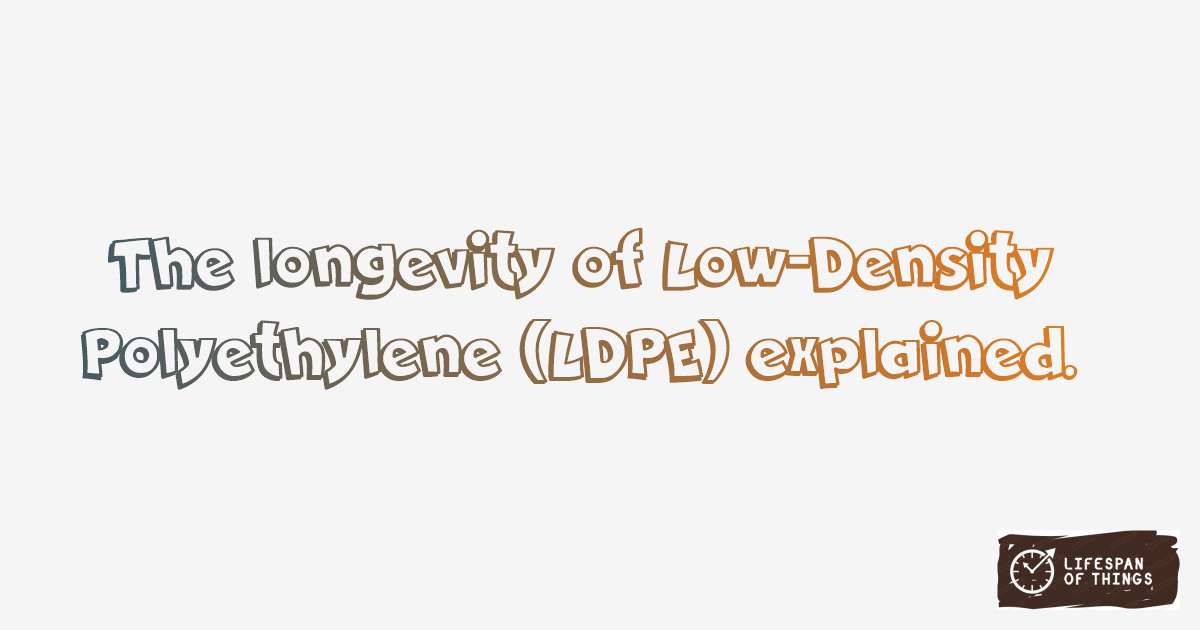
10 - 15 Years
Lifespan of Low-Density Polyethylene (LDPE) is 10 - 15 Years. Low-Density Polyethylene (LDPE) longevity is influenced by factors like exposure to UV rays, temperature fluctuations, and chemical interactions. Proper storage and handling can extend the life of LDPE products, ensuring their functionality and integrity over time.
Useful Information
Low-Density Polyethylene (LDPE) is known for its flexibility, impact resistance, and chemical inertness. Different types of LDPE may vary in density, stiffness, and transparency, catering to diverse applications such as packaging films, containers, and pipes.
Learn about the lightweight nature, chemical resistance, and moldability of commodity plastics like polyethylene and polypropylene. Read more
Low-Density Polyethylene (LDPE) finds wide usage in packaging, agriculture, and medical devices due to its lightweight nature and moisture resistance. Its versatility extends to plastic bags, wrapping materials, and squeeze bottles, showcasing its adaptability across industries.
Low-Density Polyethylene (LDPE) exhibits good durability in various environmental conditions, though exposure to high temperatures or harsh chemicals can affect its lifespan. Factors like oxidation, stress cracking, and abrasion influence the longevity of LDPE. Proper maintenance, including regular inspection and cleaning, can enhance its durability.
The production and disposal of Low-Density Polyethylene (LDPE) have environmental implications due to energy consumption and waste generation. Choosing recycled LDPE products or adopting sustainable practices like recycling and waste reduction can mitigate its environmental impact. Embracing biodegradable alternatives can also contribute to eco-conscious decisions.
To care for Low-Density Polyethylene (LDPE), avoid exposure to extreme temperatures and direct sunlight to prevent degradation. Regular cleaning with mild soap and water helps maintain its appearance and integrity. Storing LDPE products away from sharp objects and chemicals preserves their condition. For damaged LDPE items, consider professional repair services to extend their usefulness.
Lifespan Comparisons
| Compared Item | Comparison Description |
|---|---|
| Lifespan of High-Density Polyethylene (HDPE) | High-Density Polyethylene (HDPE) lasts significantly longer than Low-Density Polyethylene (LDPE), with a lifespan ranging from 50-100 years. |
| Lifespan of Expanded Polystyrene (EPS) | Expanded Polystyrene (EPS) stands out with an impressively long lifespan of 100-1000 years compared to Low-Density Polyethylene (LDPE). |
| Lifespan of Polypropylene Copolymers | Polypropylene Copolymers share a similar lifespan to Low-Density Polyethylene (LDPE), lasting approximately 10-15 years. |
| Lifespan of Thermoplastic Elastomers (TPE) | Thermoplastic Elastomers (TPE) slightly outlast Low-Density Polyethylene (LDPE) by approximately 5 years, with a lifespan of 15-20 years. |
| Lifespan of Carbon Fiber | Carbon Fiber offers a comparable lifespan to Low-Density Polyethylene (LDPE), lasting around 10-20 years. |
| Lifespan of Glass Fiber | Glass Fiber has a longer lifespan compared to Low-Density Polyethylene (LDPE), lasting approximately 20-50 years. |
| Lifespan of Polymer Matrix Composites | Polymer Matrix Composites have a lifespan similar to Low-Density Polyethylene (LDPE), lasting around 15 years. |
| Lifespan of Metal Matrix Composites | Metal Matrix Composites also have a lifespan similar to Low-Density Polyethylene (LDPE), lasting approximately 15-20 years. |
| Lifespan of Canned Fruit Cocktail | Canned Fruit Cocktail and Low-Density Polyethylene (LDPE) share a relatively short lifespan of 2-5 years. |
| Lifespan of Coca-Cola | Carbonated drinks like Coca-Cola and Low-Density Polyethylene (LDPE) have a similar lifespan of 2-5 years. |
| Lifespan of Pepsi | Pepsi's lifespan is significantly longer than Low-Density Polyethylene (LDPE), lasting about 30-50 years. |
| Lifespan of Sprite | Sprite has a much shorter lifespan than Low-Density Polyethylene (LDPE), lasting only 3-5 days. |
| Lifespan of Dr Pepper | Dr Pepper stands out with an exceptionally long lifespan of 10-15 years compared to Low-Density Polyethylene (LDPE). |
| Lifespan of Mountain Dew | Mountain Dew's lifespan is relatively short compared to Low-Density Polyethylene (LDPE), lasting around 1-2 years. |
| Lifespan of Red Wine | Red Wine and Low-Density Polyethylene (LDPE) share a similar lifespan of approximately 2-5 years. |
Frequently Asked Questions
Lifespan of Low-Density Polyethylene (LDPE) is 10 - 15 Years.
Exposure to high temperatures can impact the lifespan of LDPE, so it's important to avoid extreme heat to maintain its integrity.
LDPE is widely used in packaging, agriculture, and medical devices due to its lightweight and moisture-resistant properties.
The production of LDPE can have environmental implications due to energy consumption and waste generation, encouraging the adoption of sustainable practices.
Regular cleaning with mild soap and water can help maintain the appearance and integrity of LDPE products, keeping them in good condition.
Factors like oxidation, stress cracking, and abrasion can influence the longevity of LDPE products, highlighting the importance of proper maintenance.
Choosing recycled LDPE products or embracing biodegradable alternatives can help mitigate the environmental impact of traditional LDPE production and disposal.








